Official Site || Steam Page || Indie Game Stand Page
Contra was one of the first games to contain the famous Konami Code and many still fondly look back on it and several of its sequels, but it has a formula which is hard to get right (even Konami got it wrong plenty of times). With constant pressure from all sides, colossal bosses, and completely insane enemy designs, Super Cyborg is a rare game which hits all the right marks.
Super Cyborg sticks very close to its source of inspiration right down to the first level taking place in a jungle and every jump turning into an aerial somersault, though there are a few important changes. You can rapidly shoot in eight directions simply by holding down the attack button, capsules containing guns or other upgrades come waving in from various directions, you move at a somewhat slow yet steady pace, you die in one hit from anything, and you have a fairly large hitbox while walking, but a much smaller one when ducking or jumping; all of these elements are standard for this type of game and even feel like perfect copies of their Contra counterparts. One of the more decidedly unusual elements is the ability to toggle on a fixed mode where you can lock your character in place while still aiming in any direction, though strafing is out of the question. Every weapon, including your default gun, has an alternate fire in the form of a charged shot which can be either briefly charged for a slightly stronger attack or fully charged for a much stronger and more impressive attack.
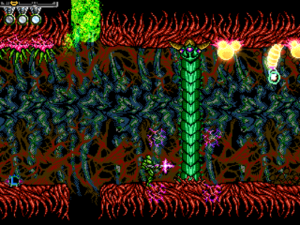
The most notable feature of Super Cyborg is its checkpointing and saving features. You start with four lives per continue, there are infinite continues, the game automatically saves at the start of each level, and the final two levels, six and seven, even have saves shortly before their boss fights so you don’t need to go through their rather lengthy areas again if you die to the boss. Interestingly, there are also two different ways to take advantage of this saving mechanic. If you run out of lives and choose to continue, you will begin at the start of the level (or the checkpoint if you’ve hit it in six or seven) with four lives, the default gun, and no points. On the other hand, choosing to quit to the main menu after you run out of lives and reload your save will still put you back to the start of the level, but with your score, number of remaining lives, and weaponry all intact from when you first reached that level. Thus, the game rewards you with a handy save to go back to if you started a level with a high number of lives and/or a great weapon, but you also aren’t punished too severely for choosing to continue instead. We’ll be looking at the implications of the fixed toggle and this generous checkpointing soon enough, but first I want to go over the weaponry.
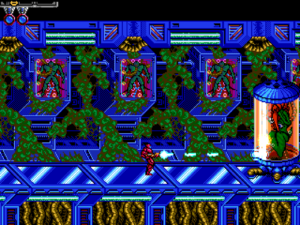
Other than the default gun, there are four weapons in this game as well as two other upgrades, many of which will be very familiar to Contra players. The non-weapon upgrades consist of a barrier which grants a few seconds of invincibility and an ‘R’, which presumably stands for ‘Rapid Fire’ as it will significantly boost your attack speed until you die even if you change weapons after picking it up. The machine gun is basically your default gun, but with bigger bullets, more damage, and a faster rate of fire and its charge shot balances it out with a slow and strong blast; this is a balanced weapon, but it’s probably my least favorite of the four as it simply does everything your default gun does except better. The laser has extremely high damage and pierces through enemies with a charge shot in the form of a large double helix laser. Its high damage and piercing capabilities make the laser great for swarms of enemies and large, single foes alike, but its size makes it difficult to hit fast opponents or enemies attacking from odd angles. It shouldn’t be too surprising that this game has a spreadshot weapon, but it’s balanced out in this case by having a slow rate of fire and low damage on individual bullets with a charge in the form of a massive spiral of bullets. Overall, the spreadgun is still great for most situations, but it’s not far and away the best weapon in the game as it instead serves as the opposite of the laser with low damage at anything beyond point blank range and high accuracy. As to my personal favorite, that award goes to the electricity attack, which shoots out large balls of electricity at a decent rate with damage nearly on-par with the laser. The most interesting thing about this final attack is the fact that when it collides with a wall or an enemy it sends out four diagonal tendrils of electricity, eight tendrils to include cardinal directions if it’s charged, which can allow it to hit multiple enemies if they are near each other and to kill enemies hiding behind barriers which even the laser can’t pierce. The weapons all feel well-balanced with no weapon coming across as far superior or inferior to the others and the game is consistently great at sending you capsules with the most suitable weapon(s) for upcoming segments and bosses. The one fairly minor issue as far as weaponry goes is with the default gun as its decent rate of fire and low damage make it suitable enough for the levels, but its damage is so much lower than the other weapons that if you die at the start of a boss fight or right before it and lose your weapon you can expect the fight to take at least two to three times longer than it otherwise would have and even the charged shot for the default gun is nothing more than a small and still rather weak blast. There are also apparently several secret powerups to be found in the game, but they must be rather well-hidden as I was not able to find even a single one of them during my playthrough.
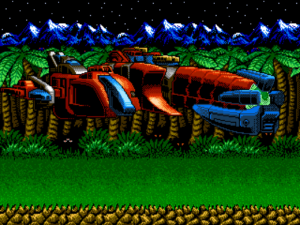
With the ability to adjust your aim without moving comes some creative and challenging level design. Since you can already aim to either side or straight up while standing in place without this toggle, the main benefit granted by this fixed mode of attack is the option to aim diagonally without constantly walking forward or backward. As a result, there are plenty of turrets and other stationary hazards which are placed in corners or which are best dealt with from an angle. For example, the fifth level has grubs on the ceiling which spit out several bubbles at a time below them; the bubbles pop harmlessly if they hit a wall, but they will send a bullet towards you if you shoot them so the best countermeasure is to aim diagonally at the grub and then either wait for the bubbles to disappear or carefully pop them. Slopes and diagonally-arranged sets of vertical platforms are also numerous and the game will constantly challenge you to quickly find the best way to hit enemies charging down or jumping up towards you, which can be particularly difficult with small targets. Even most bosses have weak points which can be most effectively hit when aiming diagonally. Levels and bosses alike are built to teach, and often require, you to rapidly alternate being locked in place in order to get in a few solid hits and moving around to avoid attacks, giving this game a distinctive feel despite how closely it otherwise sticks to its sources.
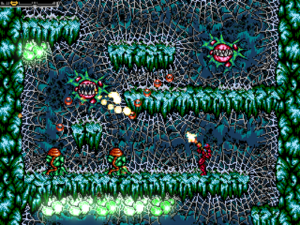
I should probably mention that there is a very good reason for why Super Cyborg is so generous with continues and saves. Namely, this game is extremely hard and packs plenty of danger into each of its seven levels. Taking yet another note from Contra, sets of weak mutant soldiers will periodically appear and run forward, jumping up onto platforms and often jumping straight off of ledges into bottomless pits. This endless assault exists to keep up a near-constant sense of pressure and to prevent players from finding a completely safe location from which to attack stronger enemies, but Super Cyborg takes it a step further with faster and more frequently-appearing soldiers in later stages and soldiers which don’t only charge in from behind you, but also from in front or even sometimes from above or below, often appearing from two or three of these directions simultaneously. The level design itself is also quite brutal as you’ll be climbing vertical shafts, fighting for every inch of ground in winding corridors, and making precarious jumps over pits and under spikes while shooting and dodging enemy fire. Boss fights are usually intense and involved with nearly every boss in the game having two or three distinct phases, but even normal enemies have their own fair share of dangerous attacks and Super Cyborg is a game with a clear love for enemies whose primary form of attack is to sit around and spawn even more enemies. Though this is a game where muscle memory and memorization in general certainly go a long way, the levels never feel so unforgiving that you are forced to memorize them and bosses are generally quite good at telegraphing the general area each of their attacks will be aimed at.
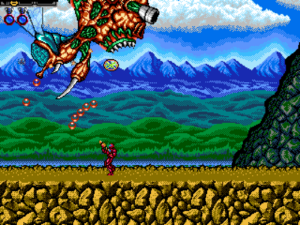
While the high difficulty usually results in a satisfying challenge, there are two points during which the balance feels like it could use some work. The first of these points comes in the form of the boss of the third level. The level itself is actually one of the easiest in the game with the only particularly dangerous moments occurring when you need to deal with small mutant frogs on slopes where it is hard to hit them. However, the boss of this area is an enormous wasp which is half organic and half mechanic and has three distinct phases. The second and third phases are both fairly short and of the two only the third phase poses a serious threat, but the first phase is where the problem lies as it feels like it requires some degree of memorization. The boss enters the screen by flying in from the bottom-right corner, so you may very well already lose a life if you are near the right side of the screen at the start of the fight. It also has a diving attack which is indicated by a distinct noise from off-screen, but you need to duck in a corner to avoid getting hit and it’s unlikely that a player would be able to get to safety in time, or even necessarily know where safety is, the first time they hear the noise. This phase also has a machine gun attack which is, like the diving attack, best avoided by ducking in the corner. Though it doesn’t take too many hits to knock this boss into its second phase, the only time it exposes its weak point is during the final attack in its cycle where it shoots clusters of slow-moving bullets at you, meaning you will likely end up going through its full attack cycle two times, if not three on every attempt. It does not at all help that this level happens to have a miniboss with a simply pattern and plenty of health. This fight gave me far more trouble than any other fight in the game other than the final boss, which thankfully has a checkpoint near it, and, unlike the final boss, it’s a fight which spends most of its time on a phase which at first feels frustratingly cheap and then becomes frustratingly dull as you dodge its biggest attacks simply by ducking in the same corner and wait to be allowed to attack.
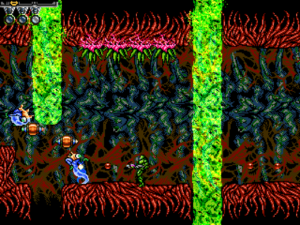
The other difficulty-related issue in Super Cyborg surprisingly swings in the exact opposite direction. The sixth level changes things up substantially by switching to an overhead view similar to that of several of the levels in Super C, though more zoomed out in this case. It’s a creative twist where you need to get used to no longer being able to duck or jump and where both your own attacks and those of enemies have limited range, and I certainly applaud the effort, but the level itself is just far too easy and goes on for far, far too long. This is the only level in the game where you are not constantly assaulted by mutants, so it already has a significantly more relaxed pace than the rest of the game. The most common enemies are large green things which slowly walk towards you and soak up a large number of hits; they would be dangerous if they served as living shields for more dangerous enemies, but they are usually alone or in groups with each other. The majority of the stage itself is also surprisingly bland to look at, taking place in a toxic waste facility filled with plenty of grey tiles and brass tubes, though there are still some neat visuals like a sewer flowing with pulsing green toxic waste and large alien spinal cords to walk across. There are also still some neat enemy designs, such as things which look like large spinning molecules which you need to use your bullets to push away from you until they explode. Unfortunately, nearly every enemy in this level with a ranged attack can be defeated by waiting for it to attack, stepping forward to take a few shots before backing away, and repeating the process until it dies. The boss fight at the end is actually great is it takes place against an enormous crab monster with plenty of claw swipes, lasers, bullets, and spinning electrical orbs. The low difficulty and overly extensive length of this level isn’t as much of a problem as the issue of the boss of the third level, but when I lost my last life to the boss and found myself at a checkpoint in the final corridor leading up to the fight I was nothing more than relieved at not having to slog through the level again.
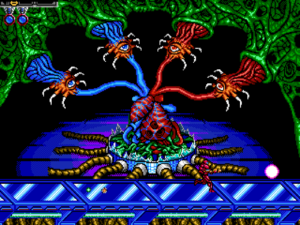
If you like weird, gross, or just plain crazy enemy designs, you will love everything about Super Cyborg’s aesthetic. This game has a real passion for slapping human faces onto just about everything just about anywhere and for tossing around eyeballs and green slime like confetti. Sure, the vaguely reptilian soldiers running at you in the first level don’t seem all that bizarre, but then you see the tent-shaped monsters they emerge from the mouths of and the only way I can even think of to describe the boss is that it’s a lump of flesh with a pig nose and a large socket which alternates between containing an eye shooting bullets and a mouth shooting exploding eyes and even that description isn’t enough because said lump of flesh is attached via machinery to the end of a giant green stalk bursting through the wall of a building which presumably hides an even larger body behind it. This is to say nothing of the human-faced bats which spit out small eyeballs which themselves fly around with bat wings or the giant heart with four large veins leading up to distorted human faces attached to insect hives in the ceiling or just about any part of the fifth level, which takes place inside the body of an enormous mutant insect. The Contra series has always had its fair share of biomechanical monstrosities, but Super Cyborg definitely takes things to another level with its designs and I couldn’t be happier.
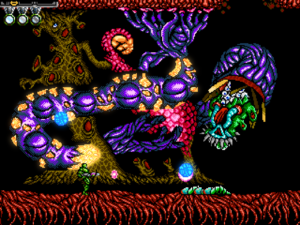
As I wrap things up, there are a few last bits of polish which I feel are worth noting. This game supports both local and online co-op modes, the latter of which is always a pleasant surprise to find in an indie game. You also have two slightly different cyborg models to choose from, in addition to at least one unlockable character; the differences between characters are purely cosmetic, but you also get a decent amount of color customization as well. Online leaderboards are also present and there are plenty of save slots to choose from just in case you need them. Lastly, there are two difficulty options by default and an unlockable third difficulty; the only difference I noticed between them was that enemies move and attack more quickly in higher difficulties, but this actually has a much bigger impact on the challenge than you might think and certainly is a step above just giving you less lives per continue or giving everything more health.
In short, if you wanted to have more Contra in your life (and Konami certainly isn’t about to provide that any time soon beyond a potential pachinko machine or two) Super Cyborg is a safe bet as it perfectly mimics the feel of the movement and the combat, throws in a few fun twists of its own alongside solid level design, and, with the exception of a few stumbling blocks, provides a high amount of challenge which remains fair and exciting throughout.